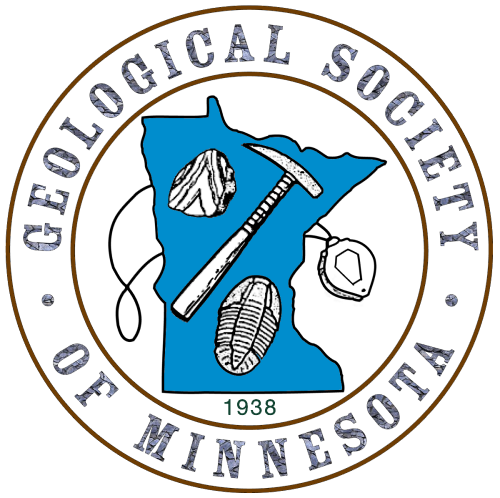 Past Field Trip Title: A FIELD TRIP TO THE NORTH SHORE
Past Field Trip Title: A FIELD TRIP TO THE NORTH SHORE
A FIELD TRIP TO THE NORTH SHORE
The trip would start at about 4 PM on Friday, May 19
and end Sunday evening, May 21, and a bus will
provide most of the transportation.
Here is a list of stops:
TENTATIVE GUIDE FOR GSM FIELD TRIP,
NORTH SHORE OF LAKE SUPERIOR
May 19-21, 2006, Richard W. Ojakangas, Leader
DAY 0. Pick up by bus in twin cites and travel to Duluth
DAY 1, SATURDAY
STOP 1-1. Thomson Hill Rest Area, Duluth. (To view drowned St. Louis River Valley, Duluth-Superior Harbor, Duluth Gabbro.)
STOP 1-2. Two Harbors. (View ore docks, original locomotive, lava flows, agates?)
STOP 1-3. Flood Bay east of Two Harbors. (Walk pebble beach, collect rocks & agates.)
STOP 1-4. Silver Creek Cliff & tunnel. (Observe diabase sill that was intrusive into lava flow sequence, columnar joints, chilled margin, underlying deformed flows.)
STOP 1-5. Gooseberry Falls State Park & Rest Area. (Rest stop, basalt flows with amygdules, waterfalls,)
STOP 1-6. Silver Bay. (Observe world’s first taconite plant, see anorthosite inclusions in diabase intrusions, discuss “asbestos” problems of 1970s.)
STOP 1-7. Illgen City. (See Palisade Rhyolite up close, discuss rheoignimbriotes, collect samples from road cut.)
STOP 1-8. Good Harbor Bay. (Read geologic marker, observe thick lava flow and thick interflow sedimentary unit, collect lava with amygdules, perhaps thomsonite?)
STOP 1-9. Bay between mileposts 139 & 140. (Observe results of wave processes, discuss wave refraction, collect various rock types.)
STOP 1-10. Grand Portage Lodge for overnight stay.
DAY 2, SUNDAY
STOP 2-1. Grand Portage National Monument. (Observe a reconstructed very historical spot, the Lake Superior end of the 9-mile-long “grand portage”, that was used for hundreds of years by the Indians and by the fur traders of the 1700s.)
STOP 2-2. Mt. Josephine roadside observation point. (View of rugged northeastern most Minnesota and Isle Royale, collect 1,850-million-year-old Rove Formation, observe Logan dike.)
STOP 2-3. Grand Portage State Park. (Walk the one-half-mile-long handicap-accessible trail to Pigeon Falls on the Pigeon River, Minnesota’s highest waterfalls, discuss why it is there. Look at Ontario across the river.)
STOP 2-4. Grand Marais. (Perhaps drive to observation point a few miles up Gunflint Trail to view the harbor and town below. In town, observe Coast Guard Station, rocks, view to southwest of the Sawtooth Mountains.)
STOP 2-5. Temperance River State Park and wayside. (Walk trail toward Lake Superior to see ropy flow tops, columnar joints, potholes in the steep gorge eroded by the river.)
STOP 2-6. Village of Schroeder. (See the waterfalls in the Cross River, Father Baraga’s monument, two lava flows.)
STOP 2-7. Sugarloaf Cove. (A very unique geologic and biological spot on the North Shore that was once a bay for assembling log rafts to be towed across Lake Superior, now a Minnesota Scientific and Natural Area. Self-guided interpretive trail. Unique geology out on the point of lava flows—ropy flow tops, clastic dikes, pipe amygdules, pebble and boulder beach, displays in the Interpretive Center.)
STOP 2-8, Rock shop in Beaver Bay. (See and/or buy agates, other rocks and gems.)
STOP 2-9. Split Rock Lighthouse State Park and Minnesota Historical Society Site. (View this site that was once so important to sailors, and its unique geology of a large anorthosite inclusion in diabase.)
STOP 2-10. Duluth, then the Twin Cites and end of trip!
4PM Friday, May 19 – Sunday evening, May 21, 2006
Trip Leader is Professor Richard Ojakangas
We will leave the Twin Cities by bus at 4PM, Friday, May 19, travel to Duluth and stay over Friday night at the Canal Park Inn. We then leave at 8AM and travel along the North Shore, staying at the Grand Portage Casino Hotel Saturday night. We return to the Twin cities Sunday evening. May 21.
We should see many signature “textbook” rock formations, vesicular and amygdaloidal rocks, waterfalls galore, and have a few opportunities for collecting. An extra perk: stories of Ojakangas’ life living in Northern Minnesota—from his childhood to the present, growing up on a farm on the Iron Range, his worldly travels…. His personal stories about the area on the last trip brought out the richness and character of the area, like frosting on a cake. Also, trip participants might bring their books to be autographed by Professor Ojakangas.
The total cost will be approximately $115 to $120 per person assuming double occupancy, not including food or tips. Of this, $50 pays for the leader and bus combined, assuming a full bus of 54 people, and $65 to $70 per person pays for the two hotel nights combined, assuming double occupancy. Not included are food, and tips for the bus driver as we;; as people who serve food (if not a buffet), possibly tips left in rooms; for those few who bring or take home the kitchen sink, tips to luggage handlers and rock movers are not included. A group meal will likely be arranged for Saturday evening. People could join the trip in Duluth and we might accommodate people wishing to stay in State Parks.
